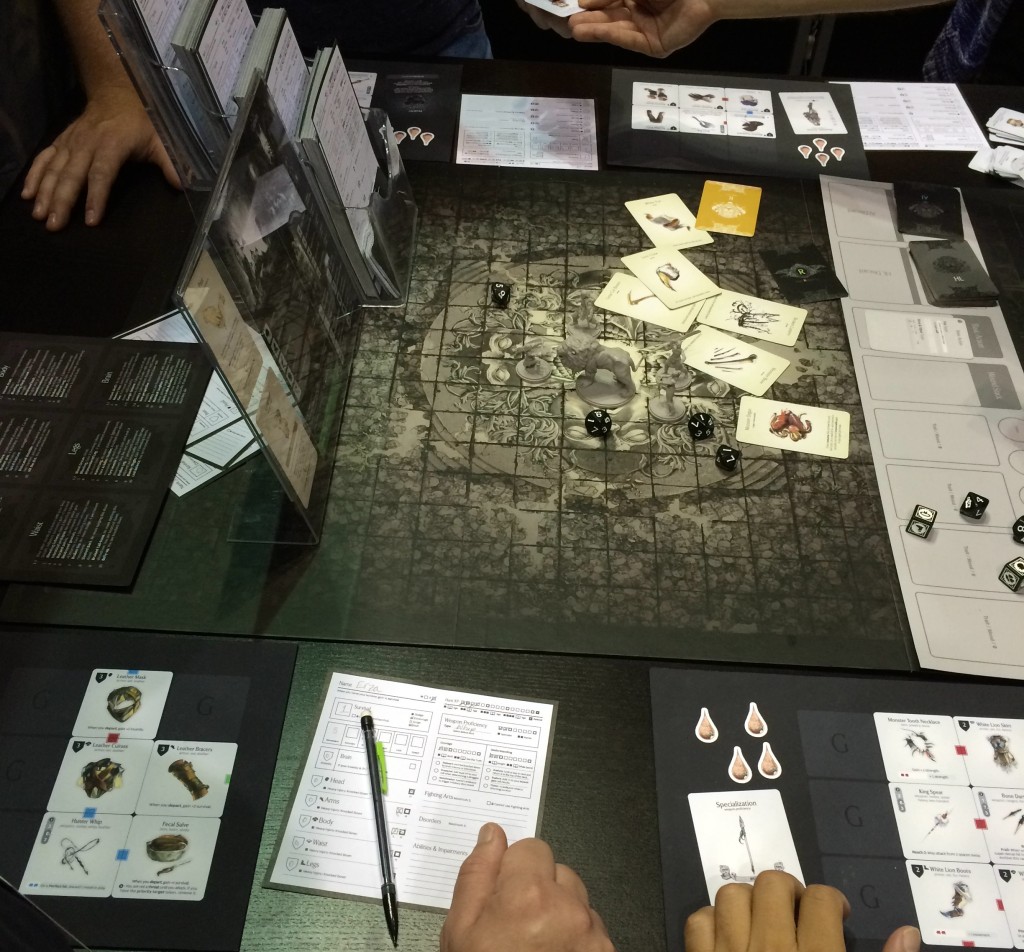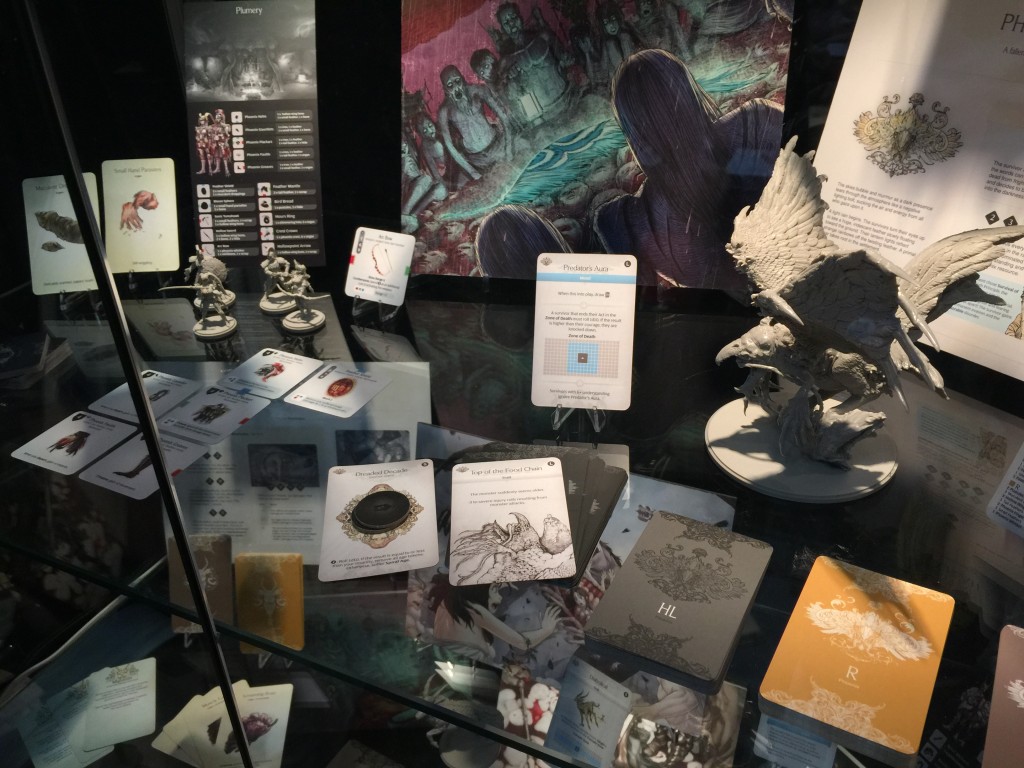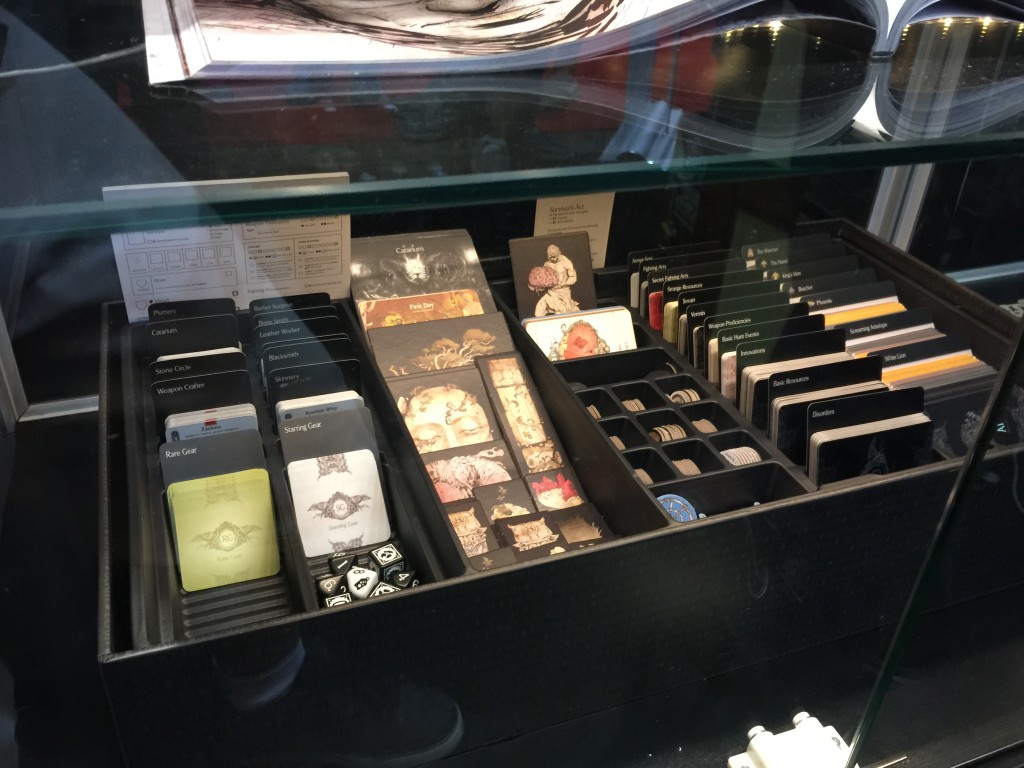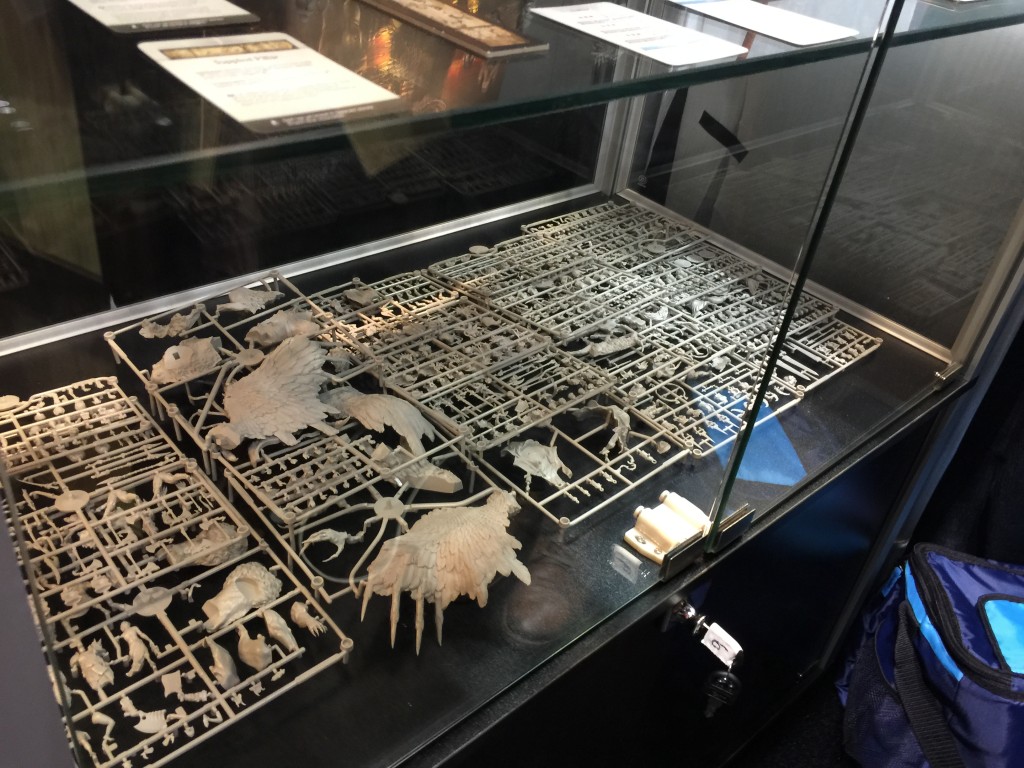When Kingdom Death: Monster’s Kickstarter launched in November 2012, it crushed its goals with more than $2 million in funding. The game was, shall we say, ambitious. The brainchild of Adam Poots, the Kickstarter showed beautiful, pre-production resin miniatures while promising an expansive board game, and promised an almost unbelievable set of contents:
- 4 35mm-scale survivor miniatures
- 4 copies of each of 6 armor kits (one armor kit can equip all 4 survivors)
- 7 large-sized boss miniatures
- 400+ cards
- 2’ x 3’ game board
- 15 terrain tokens
- 6 custom dice
- 1 rulebook-storybook, with art throughout
When I heard a Kickstarter promised such outstanding miniatures alongside a board game with euro-style development, RPG-style narrative, and tabletop wargame-style tactical elements at an almost comically high price–backers pledged $150 for the game–I was skeptical. Like many people who didn’t back the project, I assumed the game would be a loose justification to sell the admittedly gorgeous minis. Three years later, after multiple delays and setbacks, I hadn’t given the idea much thought. Saturday at GenCon, the guys from Board Game Replay invited me to join them for their demo of Kingdom Death (the full video is here)—now through production, boasting a 17 pound core game box, and sporting a shocking $400 MSRP.
I wasn’t any less skeptical, and I couldn’t have been more wrong.
The Game
Kingdom Death:Monster is a 4-player cooperative game intended to be played over 25 sessions (each session is expected to last 1-2 hours.) The game follows the awakening of a small civilization of Survivors in a dark, horrible world. In the Settlement phase of each session—roughly a year in game terms—players develop their colony, building their culture and technology in order to give their Survivors new abilities and equipment. In the Hunt phase of each session, players choose a monster to track down and trigger the narrative elements of the game. In the final Showdown phase, players fight a single monster in a GM-less tactical miniatures combat. If the monster is killed, the players bring loot back to the colony to invest in new technology and items. In the 25th session, players face a final boss and seek closure for their story.
The meat of the game, and of our demo, is in the tactical combat of the Showdown phase. There are 6 unique monsters to hunt prior to the final boss. Since there is no GM, each monster is controlled by two decks: an AI deck, which the monster uses on its turn to randomly determine its actions, targets, and attacks, and a Hit deck, which the players use to randomly assign hit locations. The clever mechanic of the Hit deck is that many cards give the monster actions to take either after being attacked, after receiving a wound, or after being hit but not wounded; this gives the monster a more competitive action economy, adding risk to every success.
Each monster uses unique AI and Hit decks, and as monsters level, they add additional cards to their decks, giving them more dangerous abilities. This results in very tailored abilities that give each monster a different feel. For example, we faced a White Lion and one of its AI cards told it to target the nearest Knocked Down player and maul him for extra damage. Alternatively, when we flipped a Hit card for the Beast’s Tail, the Lion’s reaction to being hit was to sprint forward 5 squares, knocking down any players in his path and dragging the players with him.
The components themselves are beautiful, high quality construction. While the highly configurable minis are obviously the showcase component of the box, all of the game’s art is exemplary, and the box’s insert puts them on display. The rulebook is now a fully illustrated 224 pages and the card count has ballooned over 1,000. With such a high price point, the Kingdom Death team didn’t cut any corners. I’m still not sure quite how it works, but with multiple copies of each piece of gear was included in the box, each player can build her mini to match her character’s exact equipment. Needless to say, this results in a slew of character sprues, presumably a significant portion of the box’s weight, with enough bits to make 28 Survivor minis.
Though we didn’t play through the Settlement and Hunt phases, we did get a sense of the narrative elements. The game tends to ask the players to make simple, small decisions (an early event simply asks which player will be the “Voice of Reason” in a specific time of strife) and then roll on a table for the outcome. Another scenario asks if the group will become cannibals, gaining additional resources from their fallen, or bury their dead, gaining additional understanding and culture.
While the mechanics are elegant and seem fairly simple to pick up, the game is remarkably difficult and combat is very lethal. Defeating a monster requires teamwork and planning, and there are many pyrrhic victories. The designers warned us that Survivors will die regularly, and indeed, our demo exhausted all of our resources and still ended with a single Survivor standing. When a Survivor dies, the party is assumed to return his gear to town for use by another member of the colony, so while there’s minimal cost to an individual player whose Survivor dies, the whole colony suffers in the long run. This keeps dead players engaged at the table in combat, and ready to come back the next session, since everyone benefits from a successful Showdown.
Since the players choose the monster they wish to hunt each session, I was concerned that the game had an “easy mode” of simply fighting the easiest monster each session to ensure survival. The threat of the looming final boss encourages the players to take risks by hunting the more dangerous monsters for their more valuable resources; the designers warned of a group that suffered heavy losses in an early session and was scared into fighting only the easiest monsters for the remainder of the campaign, only to be unceremoniously crushed by the final boss.
Should You Buy This?
Between the tactical combat, cooperative element, and low survivability, combined with a world that grows in depth as you explore it, I consider Kingdom Death the board game equivalent of Dark Souls. I imagine most groups will fail to defeat the final boss on their first try, and some will struggle to even reach him. If you have an interest in the game and a group that can commit to a campaign-style game, you should buy Kingdom Death.
I know, I know. That’s a lot of money. I was as skeptical as anyone when I saw the price tag, but Kingdom Death delivers on all of its promises. This was a hidden gem of GenCon: a very good game written off because of a contentious Kickstarter story and shocking price tag. But the multi-year wait the Kickstarter backers endured is firmly in the past; the Kingdom Death team assured us that the final product is on the boat from their manufacturer and expected to ship to Kickstarter backers in 5-8 weeks (September 2015), with preorders filled shortly thereafter.
So while I can’t call any game with a $400 price tag a must-buy, I will say that Kingdom Death is every bit up to the standard I expected from a $400 box. For a group of four, it’s well-worth $100 each to split the purchase. And in case you think I’ve gone nuts, I’m not the only one who was happy to see this Kickstarter cautionary tale get a happy ending; the Board Game Replay crew preordered it on the spot.
Note: Edited for typos and clarity.





One response to “Kingdom Death: Monster Hands-On: Controversial Kickstarter Makes Good”